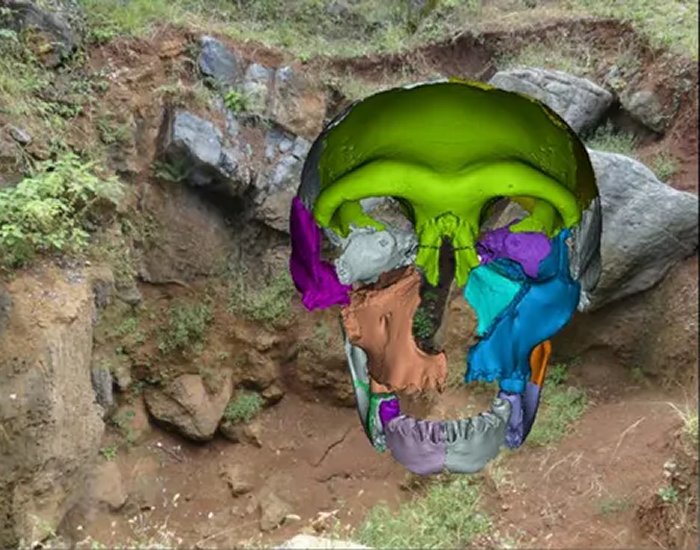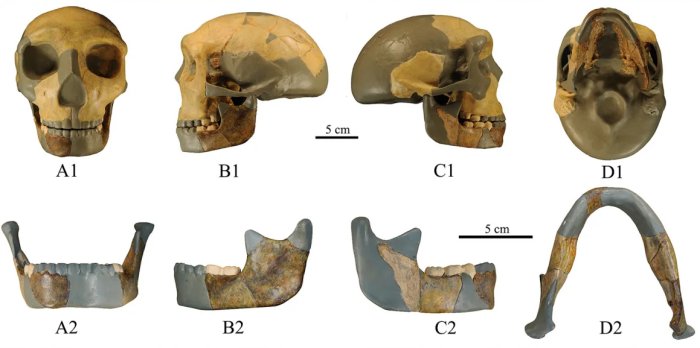Jan Bartek – AncientPages.com – There may still be vanished human species unknown to scientists. A research team has discovered an unusual 300,000-year-old jawbone with an unexpected combination of archaic and modern human features.

A computer reconstruction of the skull and jaw fragments unearthed in China. New fossil fragments suggest the skull could have come from an unknown human lineage. (Image credit: See Eurekalert (2019))
The ancient human jawbone, unearthed by anthropologists in China, belonged to a young teenager. “Given its late Middle Pleistocene age and differs from approximately contemporaneous Homo members such as Xujiayao, Penghu, and Xiahe. This mosaic pattern has never been recorded in late Middle Pleistocene hominin fossil ᴀssemblages in East Asia,” the researchers write in their study published in the Journal of Human Evolution.
The fossil traits are open to interpretation, and scientists do not want to jump to conclusions. It could be quite possible the currently unknown individual is related toHomo sapiens or our close human relatives.
The remains of at least a16 individuals have previously been unearthed at the site of Hualongdong in east-central China, roughly 750 miles (1,200 kilometers) south of Beijing. “A previous analysis of the remains showed they date to between 275,000 and 331,000 years ago, or to the late Middle Pleistocene epoch (2.6 million to 11,700 years ago) This time period is key to understanding the evolution of our own human lineage, but it’s complicated by the presence of other, now-extinct branches of the human tree, such as Neanderthals and Denisovans,” Live Science reports.
It was also at Hualongdong that scientists discovered the strange 300,000-year-old jawbone that they refer to as HLD 6. Based on current analysis, the research team has concluded the individual was between 12 and 13 years old at the time of death. Whether the person was a woman or man has not been determined. Further analysis revealed the individual had a modern, human-like face but a skull that looked more like the earliest Homo sapiens.
Using a technique called geometric morphometrics, which uses statistics to compare 3D shapes generated by the measurements scientists have compared HLD 6 to 83 other known fossil hominins. The interesting results show “HLD 6 had several features that suggest the teen had a chin — one of the hallmarks of modern humans. However, the fossil lacked some other features of chins, leading the researchers to conclude that the ancient teen did not have one.
“The HLD 6 mandible exhibits a mosaic pattern with some features commonly found in Middle Pleistocene archaic hominins, Late Pleistocene anatomically modern humans, and recent modern humans,” the researchers wrote in the study.
Even though HLD 6 has modern human-like features in their facial bones, their lower jaw has a more complicated set of traits that match the diversity within the human lineage in the Middle Pleistocene. This means that the Hualongdong individuals could be related to Homo sapiens, Neanderthals, or Denisovans, or could be another lineage entirely,” Live Science reports.

Skull of the ancient hominin from China. Credit: Xiujie Wu/National Research Center on Human Evolution
“Recent advance in hominin fossil discoveries and related studies have made the late Middle Pleistocene hominin evolution scenario in China more complicated,” the study informs.
“The data presented suggest a distinctive combination of features that supports the idea of a third human lineage in China, not sapiens nor Neanderthal,” Chris Stringer, research leader in human evolution at the Natural History Museum in London, said, adding he does not think HLD 6 is closely related to Homo sapiens.
According to Michael B.C. Rivera, a biological anthropologist at the University of Hong Kong who was not involved in the study, “this Hualongdong fossil may hint that our evolution was more gradual and nuanced than previously thought, Rivera said, and that “we are uncovering only snippets of that evolutionary history.”
See also: More Archaeology News
In order to fully understand how our human species evolved, mixed with others and moved around the world, more research needs to be done, Stringer said.
“The HLD 6 mandible provides further support for the high morphological diversity during late Middle Pleistocene hominin evolution. With these findings, it is possible that modern human morphologies are present as early as 300 ka and earlier than the emergence of modern humans in East Asia,” the researchers argue.
Written by Jan Bartek – AncientPages.com Staff Writer





